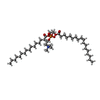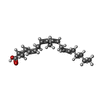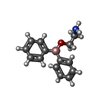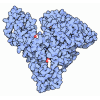[English] 日本語
 Yorodumi
Yorodumi- PDB-8v6n: Open-state cryo-EM structure of human TRPV3 in presence of 2-APB ... -
+ Open data
Open data
- Basic information
Basic information
| Entry | Database: PDB / ID: 8v6n | ||||||||||||||||||
|---|---|---|---|---|---|---|---|---|---|---|---|---|---|---|---|---|---|---|---|
| Title | Open-state cryo-EM structure of human TRPV3 in presence of 2-APB in cNW30 nanodiscs | ||||||||||||||||||
 Components Components | Transient receptor potential cation channel subfamily V member 3 | ||||||||||||||||||
 Keywords Keywords | MEMBRANE PROTEIN / transient receptor potential V family member 3 / TRP / channel / TRPV3 / TRP channels / 2-Aminoethoxydiphenylborane / 2-APB | ||||||||||||||||||
| Function / homology |  Function and homology information Function and homology informationnegative regulation of hair cycle / osmosensory signaling pathway / response to temperature stimulus / TRP channels / positive regulation of calcium ion import / sodium channel activity / calcium ion import across plasma membrane / actin filament organization / calcium ion transmembrane transport / calcium channel activity ...negative regulation of hair cycle / osmosensory signaling pathway / response to temperature stimulus / TRP channels / positive regulation of calcium ion import / sodium channel activity / calcium ion import across plasma membrane / actin filament organization / calcium ion transmembrane transport / calcium channel activity / lysosome / receptor complex / cilium / metal ion binding / identical protein binding / plasma membrane / cytoplasm Similarity search - Function | ||||||||||||||||||
| Biological species |  Homo sapiens (human) Homo sapiens (human) | ||||||||||||||||||
| Method | ELECTRON MICROSCOPY / single particle reconstruction / cryo EM / Resolution: 2.59 Å | ||||||||||||||||||
 Authors Authors | Nadezhdin, K.D. / Neuberger, A. / Sobolevsky, A.I. | ||||||||||||||||||
| Funding support |  United States, United States,  Germany, 5items Germany, 5items
| ||||||||||||||||||
 Citation Citation |  Journal: Sci Adv / Year: 2024 Journal: Sci Adv / Year: 2024Title: TRPV3 activation by different agonists accompanied by lipid dissociation from the vanilloid site. Authors: Kirill D Nadezhdin / Arthur Neuberger / Lena S Khosrof / Irina A Talyzina / Jeffrey Khau / Maria V Yelshanskaya / Alexander I Sobolevsky /  Abstract: TRPV3 represents both temperature- and ligand-activated transient receptor potential (TRP) channel. Physiologically relevant opening of TRPV3 channels by heat has been captured structurally, while ...TRPV3 represents both temperature- and ligand-activated transient receptor potential (TRP) channel. Physiologically relevant opening of TRPV3 channels by heat has been captured structurally, while opening by agonists has only been observed in structures of mutant channels. Here, we present cryo-EM structures that illuminate opening and inactivation of wild-type human TRPV3 in response to binding of two types of agonists: either the natural cannabinoid tetrahydrocannabivarin (THCV) or synthetic agonist 2-aminoethoxydiphenylborane (2-APB). We found that THCV binds to the vanilloid site, while 2-APB binds to the S1-S4 base and ARD-TMD linker sites. Despite binding to distally located sites, both agonists induce similar pore opening and cause dissociation of a lipid that occupies the vanilloid site in their absence. Our results uncover different but converging allosteric pathways through which small-molecule agonists activate TRPV3 and provide a framework for drug design and understanding the role of lipids in ion channel function. | ||||||||||||||||||
| History |
|
- Structure visualization
Structure visualization
| Structure viewer | Molecule:  Molmil Molmil Jmol/JSmol Jmol/JSmol |
|---|
- Downloads & links
Downloads & links
- Download
Download
| PDBx/mmCIF format |  8v6n.cif.gz 8v6n.cif.gz | 488.9 KB | Display |  PDBx/mmCIF format PDBx/mmCIF format |
|---|---|---|---|---|
| PDB format |  pdb8v6n.ent.gz pdb8v6n.ent.gz | 407 KB | Display |  PDB format PDB format |
| PDBx/mmJSON format |  8v6n.json.gz 8v6n.json.gz | Tree view |  PDBx/mmJSON format PDBx/mmJSON format | |
| Others |  Other downloads Other downloads |
-Validation report
| Summary document |  8v6n_validation.pdf.gz 8v6n_validation.pdf.gz | 2.1 MB | Display |  wwPDB validaton report wwPDB validaton report |
|---|---|---|---|---|
| Full document |  8v6n_full_validation.pdf.gz 8v6n_full_validation.pdf.gz | 2.2 MB | Display | |
| Data in XML |  8v6n_validation.xml.gz 8v6n_validation.xml.gz | 93.9 KB | Display | |
| Data in CIF |  8v6n_validation.cif.gz 8v6n_validation.cif.gz | 129.8 KB | Display | |
| Arichive directory |  https://data.pdbj.org/pub/pdb/validation_reports/v6/8v6n https://data.pdbj.org/pub/pdb/validation_reports/v6/8v6n ftp://data.pdbj.org/pub/pdb/validation_reports/v6/8v6n ftp://data.pdbj.org/pub/pdb/validation_reports/v6/8v6n | HTTPS FTP |
-Related structure data
| Related structure data |  42997MC  8v6kC  8v6lC  8v6mC  8v6oC C: citing same article ( M: map data used to model this data |
|---|---|
| Similar structure data | Similarity search - Function & homology  F&H Search F&H Search |
- Links
Links
- Assembly
Assembly
| Deposited unit | 
|
|---|---|
| 1 |
|
- Components
Components
-Protein , 1 types, 4 molecules ABCD
| #1: Protein | Mass: 92680.016 Da / Num. of mol.: 4 Source method: isolated from a genetically manipulated source Source: (gene. exp.)  Homo sapiens (human) / Gene: TRPV3 / Production host: Homo sapiens (human) / Gene: TRPV3 / Production host:  Homo sapiens (human) / References: UniProt: Q8NET8 Homo sapiens (human) / References: UniProt: Q8NET8 |
|---|
-Non-polymers , 5 types, 217 molecules 








| #2: Chemical | ChemComp-POV / ( #3: Chemical | ChemComp-ACD / #4: Chemical | ChemComp-FZ4 / #5: Chemical | ChemComp-NA / | #6: Water | ChemComp-HOH / | |
|---|
-Details
| Has ligand of interest | Y |
|---|---|
| Has protein modification | Y |
-Experimental details
-Experiment
| Experiment | Method: ELECTRON MICROSCOPY |
|---|---|
| EM experiment | Aggregation state: PARTICLE / 3D reconstruction method: single particle reconstruction |
- Sample preparation
Sample preparation
| Component | Name: full-length human TRPV3 in complex with 2-APB / Type: COMPLEX / Entity ID: #1 / Source: RECOMBINANT | |||||||||||||||||||||||||
|---|---|---|---|---|---|---|---|---|---|---|---|---|---|---|---|---|---|---|---|---|---|---|---|---|---|---|
| Molecular weight | Value: 0.37 MDa / Experimental value: NO | |||||||||||||||||||||||||
| Source (natural) | Organism:  Homo sapiens (human) Homo sapiens (human) | |||||||||||||||||||||||||
| Source (recombinant) | Organism:  Homo sapiens (human) / Cell: Human embryonic kidney 293 / Plasmid: pEG BacMam Homo sapiens (human) / Cell: Human embryonic kidney 293 / Plasmid: pEG BacMam | |||||||||||||||||||||||||
| Buffer solution | pH: 8 | |||||||||||||||||||||||||
| Buffer component |
| |||||||||||||||||||||||||
| Specimen | Conc.: 2 mg/ml / Embedding applied: NO / Shadowing applied: NO / Staining applied: NO / Vitrification applied: YES / Details: human TRPV3 in cNW30 nanodiscs | |||||||||||||||||||||||||
| Specimen support | Grid type: UltrAuFoil R1.2/1.3 | |||||||||||||||||||||||||
| Vitrification | Instrument: FEI VITROBOT MARK IV / Cryogen name: ETHANE / Humidity: 100 % / Chamber temperature: 295 K |
- Electron microscopy imaging
Electron microscopy imaging
| Experimental equipment |  Model: Titan Krios / Image courtesy: FEI Company |
|---|---|
| Microscopy | Model: TFS KRIOS |
| Electron gun | Electron source:  FIELD EMISSION GUN / Accelerating voltage: 300 kV / Illumination mode: FLOOD BEAM FIELD EMISSION GUN / Accelerating voltage: 300 kV / Illumination mode: FLOOD BEAM |
| Electron lens | Mode: BRIGHT FIELD / Nominal defocus max: 1500 nm / Nominal defocus min: 750 nm / Cs: 2.7 mm |
| Image recording | Average exposure time: 1.877 sec. / Electron dose: 60 e/Å2 / Film or detector model: GATAN K3 (6k x 4k) / Num. of grids imaged: 2 / Num. of real images: 25638 |
| Image scans | Width: 11520 / Height: 8184 |
- Processing
Processing
| EM software | Name: PHENIX / Version: 1.18 / Category: model refinement | ||||||||||||||||||||||||
|---|---|---|---|---|---|---|---|---|---|---|---|---|---|---|---|---|---|---|---|---|---|---|---|---|---|
| CTF correction | Type: NONE | ||||||||||||||||||||||||
| Particle selection | Num. of particles selected: 12806132 | ||||||||||||||||||||||||
| 3D reconstruction | Resolution: 2.59 Å / Resolution method: FSC 0.143 CUT-OFF / Num. of particles: 105954 / Symmetry type: POINT | ||||||||||||||||||||||||
| Atomic model building | Space: REAL | ||||||||||||||||||||||||
| Refine LS restraints |
|
 Movie
Movie Controller
Controller






 PDBj
PDBj






